What is the weakest audi a6 engine. Third generation Audi A6 with problematic engines
When going to buy an expensive car, future owners want to know which engine is the most reliable Audi A6 (C6). As you know, the cost of the power unit of any car is quite high, so future owners want to know about their capabilities, service life, consumption of operating materials, etc. technical specifications power units. In general, reviews about them are positive, but there are some problematic issues.
Which engine is the most reliable Audi A6 (C6) let's try to consider together in this article, so that all who read it have the necessary information about the reliability and efficiency of the power units of this model of the German automobile industry. The range of power units installed on these models is extensive,. Let's try to briefly consider their positive and negative qualities.

What motors are installed on the car?
Potential buyers are given the opportunity to choose a car with a motor that will meet the requirements of the future owner as much as possible. The modern engine of this car is a powerful unit, high tech, acceptable fuel efficiency, good dynamic qualities. You can choose a power plant with power ratings from 190 to 333 horsepower.
The regions of the Russian Federation are supplied with cars with “engines” that run on supercharged gasoline. Their working volume can be 1.8, 2.0, and also 3.0 liters. A series of these motors is designated as TFSI. You can find a naturally aspirated engine with a displacement of 2.8 liters FSI, as well as a diesel 3-liter power unit.
A few words about 1.8, 2.0 liters TFSI
Both of these motors in their design features are somehow twins. They are an in-line design with 4 cylinders and 4 valves per cylinder. Their cylinders have the same diameters, but differ in the piston stroke, which is slightly larger for two liter designs. This achieves an increase in working volume.
The timing mechanism is driven by a chain. It is possible to change the phases of the distribution of fuel mixture flows and exhaust valves on all valves.
"Aspirated" for Audi A6 2,8FSI
This motor may be familiar to future owners from use on previous releases of this model. It is a V-shaped configuration with 6 cylinders, which has two heads and 4 camshafts. The whole difficulty lies in the timing chain drive, since it has several chains, gears and other auxiliary parts.
If it is necessary to replace the chains and other components of this mechanism, you have to disassemble almost the entire front of the "engine". Therefore, when buying an Audi with such a motor, you need to be prepared for the material costs of repairing the engine.
Audi A6 3.0 FSI engine. In practice, this is a previously presented power unit, only with supercharging installed. This is not done through a turbine, but with a mechanically driven compressor. It is mounted in the collapse of the cylinder block in its upper part. This made it economical and more powerful.
Audi A6 3.0 TDI engine. It is also a 6-cylinder V-shaped power unit with a turbodiesel, whose power is 250 horsepower. The dynamics of the car with such an engine is very good. A common disease for diesel engines is poor quality diesel fuel at local gas stations.

More about Audi engines
The main disadvantage of engines that have direct injection is the possibility of starting the destruction of the working cylinders, or more precisely, this is the silumin from which they are made. Seizures appear on their walls, which leads to an increase in consumption. engine oil. Extraneous noise and vibration also appear, spark plugs are splashed and it happens.
All supercharged engines are "famous" for the fact that with a run of approximately 30,000 to 50,000 km, the consumption of engine oil increases significantly. Very often, the valve that responds becomes the culprit for the appearance of such a problem. Its replacement, almost always, eliminates this problem.
Of all the presented power units, the most reliable is the “aspirated”, the working volume of which is 3.0 liters. It was produced according to the old technology, when the sleeves were cast iron, which saved them from the appearance of scoring. To the displeasure of Audi owners, its production was suspended in 2008. As a disadvantage, it should be noted the need large volume work when replacing the timing drive.
As you can see, engines have both positive factors and some disadvantages. Which engine is the most reliable Audi A6 (C6) we tried to tell in this article. After reviewing it, a potential Audi buyer will already be able to independently opt for a power unit.
It was deservedly considered an extremely successful model and was produced from 1997 to 2004. The chassis design turned out to be very promising, but even the most successful cars cannot live on the assembly line forever, especially in the premium segment, where Audi has settled since the late 80s.
The new A6 in the body, which received the designation C6 / 4F, inherited many of the generic features of the previous model, including the layout and suspension design. But the body has noticeably increased in size and, of course, the entire line of engines has been replaced. No less changes have taken place inside: the MMI multimedia system is only the visible part of the iceberg. A much more complex structure of electronic units and actuators remained out of sight. Well, as expected, more chic, "premium", dynamics and ... prices. All according to the laws of the genre.
And the car was remembered for the monstrous V10 on the sports versions of the S6 and RS6. The engine is of the same modular series as the V6 and V8 FSI, but it is on the basis of this block that the unit for the new Lamborghini will be made later. And for Audi, an atmospheric version of 5.2 liters with direct injection with a capacity of 435 hp was in store. With. and a completely unrealistic biturbo with a volume of 5.0 liters and a power of 580 hp. with., and also with a good margin for additional forcing.

Pictured: Audi S6 and RS6
In the process of restyling in 2008, the car seriously changed its appearance, electronic filling and a line of motors. And then she managed to light up in a scandal with a recall in several stages of cars with a 3.0 TFSI engine, in which the piston group literally “devoured” not just quickly (which the owners are already used to), but very quickly. Fortunately, a pleasant surprise was in store for the Russian owners, leaving the three-liter V6 of the old reliable series with 218 hp in the range of engines. s., which, along with the 3.0 diesel engine, looked simply amazing against the background of the extremely problematic more “perfect” engines with their “oil burner”, failures and even fires. However, let's talk about everything in more detail.
Body and interior
Audi in this body really almost does not rust - the oldest cars are just getting point defects in the paintwork in the area of \u200b\u200bthe rear wheel arches. The paint on the front arches peels off a little earlier, but corrosion is not noticeable “by eye”, because the fenders and hood are made of aluminum. True, it also corrodes and eventually collapses, turning into a white powder.
The solid structure of the body does not allow any special liberties: the subframes are strong, like the spars and attachment points. Unless the trunk floor and floor spars suffer - the car is low, and contact with curbs and other obstacles often occurs with not very neat owners. Outwardly, this is imperceptible, but it would be nice to update the anti-corrosion layer.
1 / 4
2 / 4
3 / 4
4 / 4
Pictured: Audi A6 2.7 TDI Avant '2005–08 and Audi A6 4.2 quattro S-Line Sedan '2005–08
Also pay attention to the frame. windshield- damage to the paintwork is possible here, and the condition of the seam sealant in the engine compartment of cars with V8 and diesel V6 engines, a large load on the front end and high temperature can damage the seams very early, but such a defect is rare.
The beautiful interior of the A6 is fraught with many potential "crickets". Alas, the complexity of reinforcing work here is much higher than average, breakdowns additional equipment are common, poorly diagnosed and periodically have to remove the seats, door trim and even the dashboard to access the blocks and connectors. Collecting everything is difficult, and the materials age over time. In general, the design for multiple assembly and disassembly is not designed.
But the quality of the materials has become even better, except that the leather of the seats and steering wheel is no longer as good as on old cars, fraying is common. But there are no buttons with white worn zones, all the inserts are silvered or delight with a wooden sheen, like new ones, for many, many years. And small things work well even in age, the buttons do not lose their elasticity and clarity of switching.
1 / 2
2 / 2
Interior Audi A6 Allroad 4.2 quattro'2006–08
Serious damage? The climate unit can "please" the failure of one of the six gear motors. New roads, and changing a failed part is long and dreary, services often offer to remove the entire dashboard to complete the work. The fan motor is not particularly reliable, climate displays “burn out” over time - cables lose contact, MMI loses sound, buttons, settings, navigation ...
The control keys on the central tunnel are in the vulnerable zone - they are often tritely filled with liquid. By the way, sometimes the sunroof and autumn leaves- they clog the drains, and then the water flows into the salon, right in the center.
1 / 2
2 / 2
Interior Audi A6 Allroad 3.0T quattro'2008–11
A broken handbrake button is already our “trick” - many owners try to “drift” or simply pull sharply, “until it clicks”. It is clear that the Germans did not count on such barbarism, the key simply breaks. And the cigarette lighter is poorly located, coins or metal debris can get into its vertical connector and cause a short circuit.
Otherwise, everything is fine, and the condition of the cabin depends on the quality of the service where the A6 was serviced, as well as on the number of breakdowns in the interior electronics. The cars are not so old, a complete set of problems is present only on completely abandoned copies, killed by a “high-quality” dealer service with repeated replacement of elements, and on traveling cars that are operated “for slaughter”.
Electrical and electronics
It is the electronics of the machine that owes the appearance of almost all salon “problems”. After all, there are a bunch of independent electronic units with their own settings and features. Any breakdown of the electrics on the A6 is not solved by a fifteen-minute visit to an electrician, but by the serious work of people specializing in such electrics. And paid accordingly.
For example, a non-working seat heating came out at ... 42 thousand rubles. Well, what do you want, 10 thousand - work on finding and flashing blocks, 32 thousand - the price of a new block and replacement work. By the way, the heating mat itself in the seat was intact, if it broke, then it would be another 20 thousand, if you do not introduce "emel" instead of the original rugs with precisely calculated heating zones.
Can you imagine how much it would cost to repair a handbrake? Wiring harnesses to the right and left rear caliper, and even fixing the button and removing the error? Yes, minus 50 thousand rubles from the budget. Failed mirror adjustment? A new door block and comfort block firmware, the issue price is 30 thousand rubles with a used replacement block.
No battery charging? Oh, the choice of problems is truly rich, from the most banal generator failure to a failure in the charge control system, and replacing the generator is still a “successful” option.
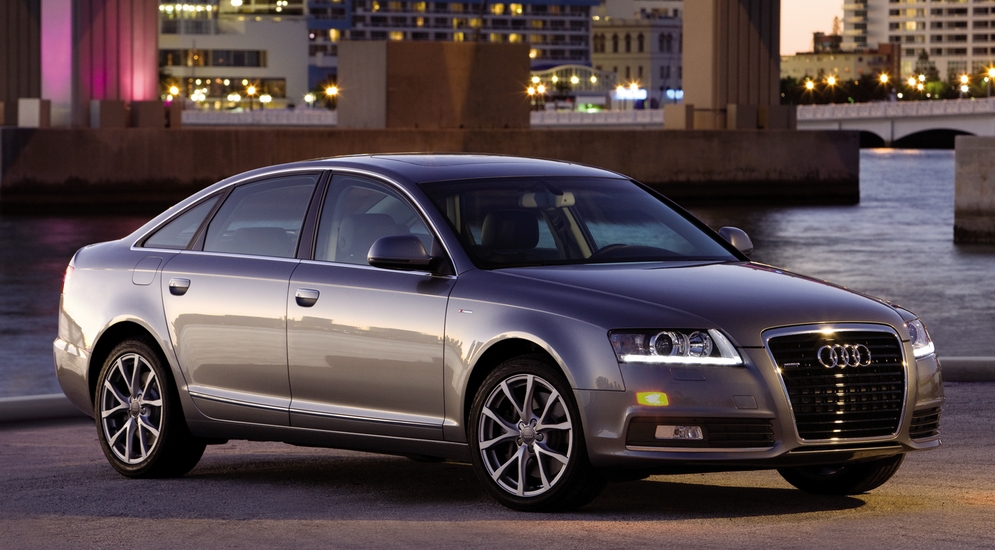
This car needs a lot of love. And never quit, otherwise then it simply cannot be restored. There are more than three dozen electronic components, they all fail in very different ways: someone dies quietly, someone puts the entire bus and stubbornly defies diagnosis, someone gives out something much more ingenious. The system can work for years without failures, but if problems appear, they are solved for a long time and expensively.
Of the more banal, purely electrical problems - the headlights, correctors, reflectors, the glass itself die, there is another trouble in restyling - the LED line goes out. If the ESP acceleration sensor fails, half of the “very necessary functions” stop working and an error lights up for ... correctly, for the ABS unit. In general, without a scanner and knowledge of the features of the machine, there is nothing to do here.
And the engine compartment on 4.2 engines and sensors do not last long - they are hot. Starters and fans don't last long on all petrol V6s and V8s. The rear parking sensors suffer from weak sensors.
I'm afraid that the list of those electronic components that ruin the lives of their owners quite regularly will be long. There are too many of them to highlight really serious patterns. The future owner just needs to be ready for anything and take even the smallest things very seriously. And avoid service in services where such a car is seen for the first time.
Suspension, brake system and steering
Multi-link suspension has long been considered an extremely problematic place. But even the multi-link front and rear on the A6 will not seriously unsettle the owner of the car. The price of replacing everything on a "departed" car, of course, is very high. But everything rarely breaks down at once, expensive units have inexpensive analogues, and the mileage of most elements during normal urban operation is at least 60 thousand kilometers, or even times more.
With a very careful and normal movement, the car can go thousands of 200 kilometers without serious interventions. Of course, with the V8 under the hood and on the “duct tape”, the suspension bulkhead becomes a mandatory operation at every MOT.

In front, the lower front and upper arms traditionally suffer first. At the rear, it is also the upper arms that fail first. Fortunately, almost all loaded units have replaceable silent blocks on at least one side, and the cost of spare parts is low. Separately, it is worth noting that the silent blocks of the front subframe also need to be changed regularly, especially on machines with powerful engines.
Front wheel bearings run only 100-120 thousand on cars with heavy engines and sports suspensions. At the back, the resource depends on the mode of operation: if the car often drives with a full load and on bad roads, then you will have to change it after a hundred. If this is urban operation, and even with a maximum of one passenger, then they can be said to be almost eternal.
1 / 3
2 / 3
3 / 3
Pictured: Audi A6 Allroad 3.2 quattro’2006–08
Optional air suspension is rare and notorious. But now the price of air springs is no longer prohibitive, there are substitutes and craftsmen who repair systems and even modify them. For example, you can put a sealed casing, "a-la Porsche" and strengthen the system with a large receiver.
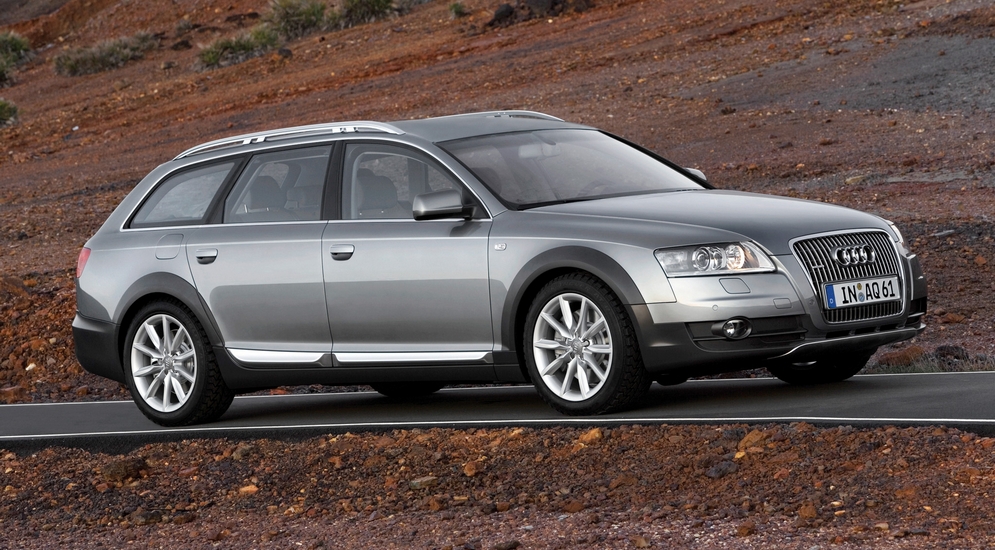

Pictured: Audi A6 Allroad 4.2 quattro’2006–08
Steering here it is completely traditional: a hydraulic booster and a rail with a servotronic. Everything is quite reliable, the rail is not prone to leaks and knocks, the hydraulics are well done, the pipes do not leak, the pump is reliable. Complaints about the short resource of steering rods and tips are mainly characteristic of cars with very wide tires.
Brakes differ in size and successful design. Large brake discs are prone to buckling and even imbalance over time and should be replaced on time. And the resource of the pads is small, but this is typical for heavy and powerful machines. Otherwise, everything is very reliable: brake pipes very rarely fail even in the cars of the very first releases, and the ABS unit suffers only from problems with on-board electronics. However, when buying a car, you should pay attention to "collective farming" - brakes from the Porsche Panamera or another custom set of brake discs and calipers are relatively common.
The handbrake often fails, but even here there are problems of a purely electrical nature - it breaks the wiring to the individual motors of its drive, and people, in addition, break the control button in the cabin.
transmissions
Manual transmissions are reliable here, but the dual-mass flywheel requires regular replacement or repair, and the pleasure is not cheap at all. The driveshaft on the Quattro and the wheel drives are strong and last a long time. With runs for one and a half - two hundred thousand kilometers, the intermediate support of the driveshaft and the front outer CV joints may give up. Quite a worthy resource. It is worth monitoring the oil level in the rear gearbox: if there are streaks on the case, then it is worth checking it regularly or repairing the breather and oil seals. If the oil leaves, it will fail very quickly.
There are two types of automatic transmissions. The Multitronic variator was installed on front-wheel drive cars, and all-wheel drive relied classic box ZF gears.
I already talked about Multitronik - at first there were continuous problems from the variator. An already heavily modified version was installed on the C6, which differs both in the control unit and in the filling of the unit itself, and it causes relatively few difficulties. Since 2005, this box can be considered very reliable, the number of failures due to design failures is really small. Since 2006, variators of the 0AN series have appeared, which perfectly digested the moment of even powerful 2.7 diesel engines and a 3.2 FSI engine.
Most of the complaints about the box are related to the mode of operation and design features. The chain variator is still a variator. He does not like slippage, abrupt starts, shock loads, towing heavy trailers and driving at maximum speed.
In addition to everything, there are generic “sores” - the cones are damaged during towing and the chain resource is 100-180 thousand kilometers. And if you tighten it with a replacement, then the chain will break the cones, and the repair will come out “golden”. With quiet operation, even with fairly powerful 3.0 MPI and 2.0 TFSI engines, the resource is very good and, most importantly, predictable. There are almost no minor failures, glitches and failures. The main thing is to check it when buying, it is very important to work on a cold one, the absence of obvious slippage and extraneous sounds during smooth movement. And after a full warm-up - about 10-20 kilometers, normal operation without twitching with traction, adequate switching during acceleration "to the floor" from a speed of 10-20 km / h and above.
Shocks and howling when accelerating, as well as hard twitches when “switching down” are unacceptable. The price of the chain itself is relatively low, about 20 thousand rubles for the "original", but if it is not changed on time, then the costs, as I said, will increase by an order of magnitude.
Six-speed automatic transmissions of the ZF 6HP19 series on all-wheel drive vehicles with engines up to 4.2 liters and 6HP26 with 5.2 engines cannot be attributed to particularly fragile structures, but you should not count on a long resource either. Active use of the blocking of the gas turbine engine during acceleration, work with the slipping of the main friction clutches sharply reduce the resource. Vibrations and wear products in the oil break the automatic transmission bushings and contaminate the valve body, which here is separated into a separate unit, called mechatronics, which also successfully fails.

If the owner drives carefully and at the same time changes the oil in the box often, at least once every 40-60 thousand kilometers, then it will pass more than 200 thousand, and the amount of restoration work will not be very large: repair of the gas turbine engine, replacement of friction clutches and something little things.
But usually the operation is much tougher - frequent races with gas to the floor (remember, this is a Quattro), irregular oil changes at intervals of 60-100 thousand kilometers or “before impacts”, plus constant overheating of the box. It is surprising that the design can withstand at least 150-200 thousand kilometers in such conditions. But the repair cost...
To replace the clutches and linings of the gas turbine engine, the repair of the box bushings is added - they are broken by dirty oil with vibrations, plus the repair or replacement of the mechatronics. The mechatronics unit costs 300 thousand rubles, repairs - from 15 thousand, but the typical price of intervention is about 50-70 thousand rubles. The quality of the repair at the same time - "how lucky." And even a purchase by a competent owner often no longer saves from expenses - switching to a regular “partial” oil change at every or every second maintenance, installing a reinforced automatic transmission radiator with a filter will only prolong the agony. If the oil pressure in the automatic transmission is already low, then wear will proceed at an accelerated pace, and any “acceleration to the floor” will sharply reduce it.
And, unfortunately, boxes with runs already from 80-100 thousand begin to act up: shocks during switching, failures, illogical work. The problem is not always easy to localize, many cars drive like this for years. Fortunately, the adaptive capabilities of the control system are great and the dealer scanner with the new firmware works wonders: often already clearly dying designs go to the last spurt and extend another 30-50 thousand km of completely normal operation after adaptations.
Both the CVT and the ZF 6HP automatic often break the owners with their attitude. You need to understand that a powerful car is bought in order to use its power, and not to stand in traffic jams. The CVT provides a minimum number of failures with careful operation and a stable resource, and the ZF “automatic” allows the driver a little more, provides better dynamics, better tolerates hard accelerations, but will also not endure bullying for a long time.
Motors
Audi tried to make big car dynamic and economical. Therefore, almost all engines of that period were with direct fuel injection, as light as possible and unified. Among the A6 engines, only three gasoline ones stand out from the general row. It is a 2.0 TFSI (BPJ), 3.0 V6 MPI (BBJ) and 4.2 V8 MPI (BAT) turbocharged inline-four. All these are the last motors of the old series related to EA113.
Three-liter is an outlet for Audi owners, it is powerful, 218 hp. s., s good sound, and reliable - not at all prone to oil appetite. The larger V8 4.2 essentially differs from it only in an extra two cylinders, a tighter layout and frankly excess power. The supercharged two-liter is not so reliable, more often suffers from an oil appetite, but is simpler in design and, as a result, cheaper to operate. It has an excellent margin for boosting: let me remind you that the same engine was in fact on the Golf R VI, and there they removed 300-450 hp from it. with., which is comparable to the impact of the V10 on the S6.

All engines - with a combination of a belt and chain in the timing drive, cast-iron sleeves with inexpensive spare parts and a minimum of problem areas. Of course, turbocharging at 2.0 requires a quality service, and direct injection of the first generation is rather whimsical, but there are adapters for more modern high-pressure fuel pumps and injectors, high-quality firmware. As a result, of the gasoline engines, these three are rightly considered the best. With regular replacement of the timing, consumables, ignition modules and maintaining the control system in good condition, the number of problems is minimal, the resource is obtained far beyond 300 thousand.
A series of engines 2.4 MPI (BDW), 2.8 FSI (CCDA / BDX / CCEA), 3.2 FSI (AUK), 4.2 FSI (BVJ), 5.2 FSI (BXA) and 3.0 TFSI (CAJA) essentially differ only in the number of cylinders and piston stroke . They have a unified cylinder diameter of 84.5 mm, and the younger engine is distinguished by a simple distributed injection. These motors also have common problems.
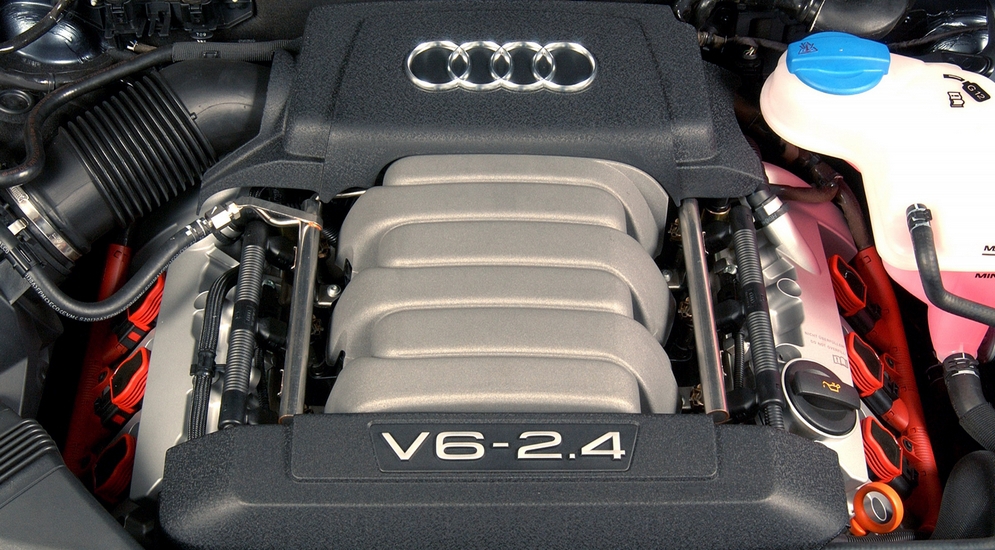
A complex and expensive timing chain has a short resource, is prone to chain slippage at the slightest drop in oil pressure or wear. The piston group greedily absorbs oil through failed piston rings and valve seals. And soot, high working temperature and a wonderful “innovation” in the form of a scraper-type compression ring destroys the delicate alusil coating very quickly.
The 3.0 TFSI was especially noted, on which, contrary to the designation, there is no turbine - there is an Eaton compressor here. This engine has problems with piston group manifested themselves during the warranty period, and often. The company really did not want to change something in the “successful” design, and as a result, thermostats were changed as part of the revocable company, and those who were persistent were still replaced with cylinder blocks. Of course, after the end of the warranty, the number of replaced units began to wane, because not many people use the “kulan” (extended warranty), and a solid part of such motors has an oil appetite of more than a liter per thousand kilometers.
On 4.2 FSI engines, the cylinder block also turned out “with a surprise”. With ridiculous runs, up to 50 thousand kilometers, many cars went to replace the block with wear on the seventh or eighth cylinders. As usual, the company does not name specific numbers of failures, this terrible secret is known only to the legendary "warranty managers", and they do not disclose it. But judging by the reviews of the owners, almost all units turned out to be problematic.
Fortunately for the image of the model, few such motors were put on it, but on the Q7 this led to a bad reputation for the car as a whole. With a completely identical engine design, for some reason, the least complaints are about 2.8 FSI, although it differs fundamentally from 3.2 only in a smaller piston stroke. Most likely, a slightly lower lateral load on the piston allows the piston to last longer, and the motor was modernized during the production process, unlike the "relatives", but it is unlikely that problems can be completely avoided.
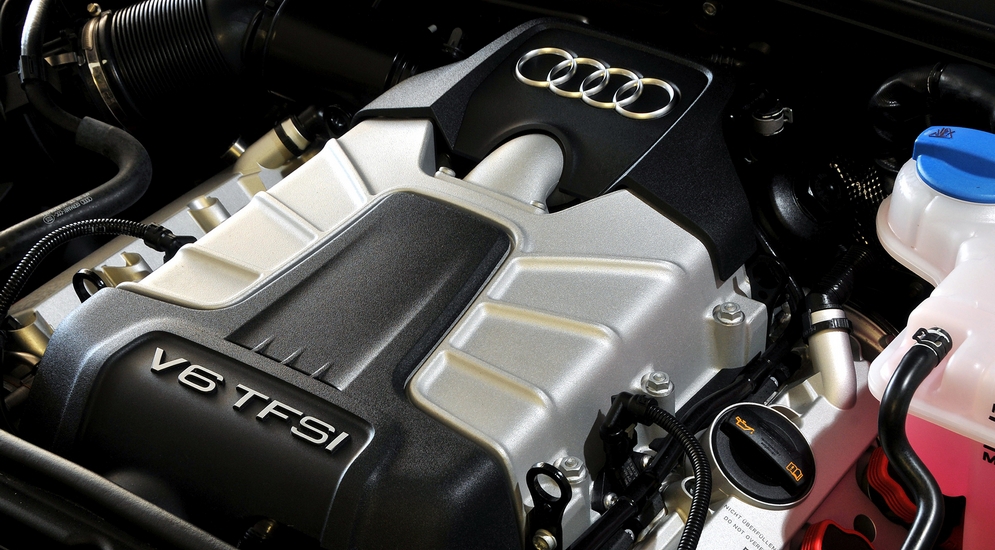
But if you want to buy a C6 in a restyled body, then only 2.0 TFSI or diesels will be an alternative to this engine series. Diesel engines are quite common on the A6, and in Europe they generally make up the majority. All the features of "diesel reliability" are present here in full. By the way, in order not to list them in every review, we recently prepared an article with a list of typical problems of any used car -. I will dwell on the features of specific motors.
Diesel engines 2.0 on the A6 - several gradations in power and two series. Engines with a capacity of 140 liters. With. BLB / BNA / BRE series - with unit injectors, very expensive, but, fortunately, not capricious. On these motors, it is worth carefully monitoring the serviceability of the oil pump bypass valve - if it gets stuck, it can squeeze out the plugs of the cylinder head oil channels, and then some camshaft cams will be without lubrication. A similar problem exists on all 2.0s, but on engines with unit injectors, the “issue price” is noticeably higher.
On a series of engines with a capacity of 136 and 170 hp. with., which were installed after restyling in 2008, the power supply system is already with piezo injectors. They are expensive, do not like overheating and have a limited resource of about 200-250 thousand kilometers in urban mode. The series of these motors are CAGB and CAHA, pay attention to this, because the repair price is not at all small. When operating in cold regions, the oil pump drive chain can stretch and even break - the cause is most often "gassing" with cold oil and, again, the oil pump pressure reducing valve.
The V6 diesel series is distinguished by enviable reliability and good power. The 3.0 motors showed themselves best. No serious problems have been identified with them, and in terms of nozzles and oil pump, the features are similar to 2.0 diesels. Of the little things - the heat exchanger is prone to leaks with age. If oil leaks, check it first. Moreover, the motor mounts here are expensive, electro-hydraulic, and their resource is 80-160 thousand kilometers. After the refusal, a completely “non-premium” vibration appears in the cabin.
Audi A6, - a business class car manufactured under the Audi brand, internal designation - " type C". Audi cars have always attracted connoisseurs of premium cars, but, due to the high cost, not everyone can afford to buy such a car new, which is why most connoisseurs of the German car industry are considering hundreds of offers in the secondary market. And, if you ask the fans of this brand why this particular car, because it is already old, and most of the mileage is already under 100,000 km, most of them will answer you - “After all, this is an Audi”, which means quality is guaranteed. Frankly, it's hard to disagree with these people, but not in the case of the Audi A6 (C6) with mileage. Today, I will try to explain under what circumstances this car is by no means worth buying, and what you should pay attention to in order to buy the car of your dreams and not be left without pants.
A bit of history:
The Audi A6 originally had an index of 100, but in 1994, engineers from the design bureau from Ingolstadt decided to adopt new rules for naming the model range, and, during the restyling of the 4th generation, the “weave” was called A6. Audi A6 (C6) debuted on the market in 2004. Initially, the car was produced only in the sedan, in 2005 the station wagon and coupe were added to the lineup. The car was designed by German chief designer Walter de Silva, who managed to preserve the family features of the Ingolstadt brand, while emphasizing the sportiness and innovative solutions of engineers. In 2005, at the international auto show in Detroit, the car was awarded the title of " The best car in the world».
In 2008, a minor restyling was carried out, during which the following were changed: front and rear optics, radiator grille and front bumper. Also, the rear-view mirrors were enlarged. In the interior, the changes affected the front panel and multimedia system. After holding out on the assembly line for seven years, in 2011 the C6 gave way to the next, fourth generation of the Audi A6 model with the C7 index.
Common malfunctions and disadvantages of the Audi A6 (C6) with mileage
Body. By and large, there should be no problems here. All steel elements are well galvanized, and aluminum, in principle, are not subject to corrosion, however, over time, however, they can corrode and even crumble. The front fenders and hood are made of aluminum, thanks to which you can easily determine whether the car has been beaten. As you know, it is quite difficult and expensive to restore aluminum parts, therefore, after an accident, most owners change them to cheaper steel counterparts. And, here, which part is installed on the car, you can determine with the help of a magnet. If, when inspecting a car under the hood, you find poor sealing of seams or microcracks, this does not mean that the car was beaten. The fact is that on cars with diesel engines and powerful gasoline engines (4.2 liters), over time, from heavy loads, the joints of the body panels become loose.
Also, you should pay attention to the windshield frame - there may be the same problems ( poor sealing and microcracks). It is worth looking under the bottom of the car, because of the small clearance, the spars and the rear floor panel often come into contact with the road, therefore, the anti-corrosion layer is damaged. It would seem that optics can cause problems, but, in the case of the Audi A6 (C6), they can be quite large. Taillights often fog up, and an additional rear stop may stop working altogether. The problem is eliminated by cleaning and bending the contacts of the LED groups. With front LED optics, everything is much more complicated. First, problems with tightness. Secondly, if at least one LED from the strip running lights fails, the entire strip will stop burning, as a result, you will have to change the entire headlight unit (about 1000 USD). To avoid high costs, you need to take care of replacing the headlight seal in advance.
Engines
Audi A6 (C6) has a fairly wide range of power units: gasoline - aspirated: 2.4 (177 hp), 2.8 (190, hp), 3.0 (218, 240 hp), 3.2 ( 256 hp) and 4.2 (321 and 350 hp), turbocharged: 2.0 (170 hp) and 3.0 (300 hp); diesel - 2.0 (140 and 170 hp), 2.7 (163, 180 hp), 3.0 (211, 224 hp). The most problematic are the engines of the series FSI TFSI, they use an aluminum block with a special Silumin coating ( aluminum and sulfur alloy), which is rapidly destroyed by high temperatures. The manufacturer claims that the resource of these power units is 250-300 thousand km, but in fact, in most cases, expensive engine repairs have to be done at a mileage of 140-170 thousand km. As a rule, the main reason is the wear of the cylinder mirror; manifested by vibrations, extraneous noise at idle and increased oil consumption from 300 grams to 1 liter per 1000 km. Also, a failed crankcase ventilation valve can affect oil consumption. 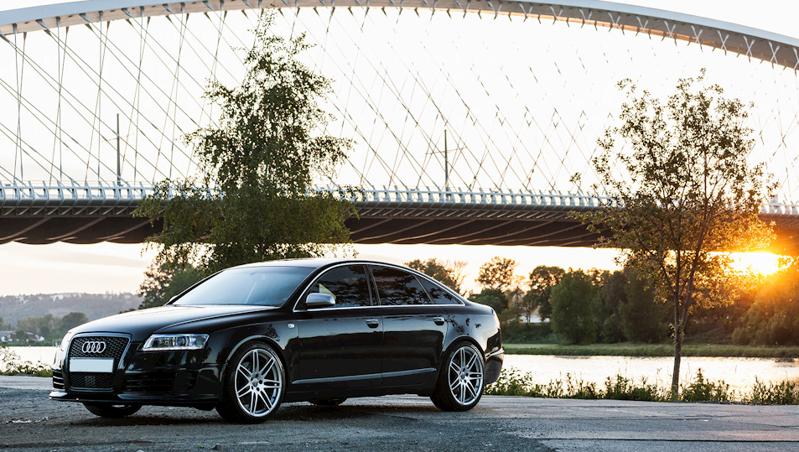
Petrol
In TFSI engines, turbines are not famous for a large resource either, in most cases they have to be changed at a range of 150-170 thousand km. Another trouble that you will have to face during the operation of the car is a small resource of ignition coils ( go up to 70,000 km). It would seem that the problem is not significant, but this is until you are given a price tag for a replacement. After 100,000 km, troubles with the timing chain tensioner are possible. If, in time, you do not pay attention to the diesel rumble that has appeared, the consequences will be the saddest ( the pistons will meet the valves). For the 3.2 engine, in addition to the tensioner, the chain may begin to stretch by 100,000 km, in which case you will have to pay about 1500 USD for timing repair. . For the 2.4 power unit, the Achilles heel is the damper on the intake manifold, if it knocks, you will have to pay more than 1000 USD for repairs.
The most reliable among gasoline engines is aspirated 3.0, but it is not without sin. The 3.0 engine is made according to the old technology using cast-iron liners ( installed until 2008), thanks to this, the owners of cars with such an engine are not aware of problems with the piston. Among the shortcomings of this motor can be noted: loss of tightness of the head gasket. Because of this, antifreeze gets into the engine ( ailment manifests itself on a run of 130-150 thousand km). Of the minor troubles of all motors, one can note the failure of the thermostat, pump and catalyst on a run of 100-120 thousand km. Power units with direct injection FSI have an unusual sound of work on idling (clatter). This feature due to the fact that the nozzles in these engines operate at a pressure of 100 bar, instead of 5 bar for similar engines with the "old" injection system.
Diesel
Diesel power units are more reliable than gasoline ones and, in most cases, 250-300 thousand km go without any complaints. The most problematic is the 2.0 engine installed on cars until 2007. It is most often bothered by: nozzles, oil pump, valve EGR, there have been cases of cracking of the cylinder block. After 2007, the manufacturer eliminated most of the defects by installing the injection system " common rail". However, the engine did not become problem-free; over time, the high-pressure fuel pump and the particulate filter bother. When choosing a car with a 2.0 diesel engine, consider the fact that the 140-horsepower and 170-horsepower versions of the power plant have many design differences. The most important of them - on a more powerful motor, piezoelectric nozzles are used, which cannot be restored.
V6 diesel engines with a Common Rail injection system are equipped with a timing chain drive, which includes a group of chains, the replacement of which will cost a fortune. Another disadvantage of diesel engines is the small resource of the dual-mass flywheel, in most cases it has to be changed at a range of 120-150 thousand km. Also, after 100,000 km, you will have to change the engine mounts and thermostat, and closer to 200,000 km - catalysts. When refueling a car with low-quality diesel fuel, the resource of fuel injectors, high-pressure fuel pump and EGR valve is significantly reduced.
Transmission
For the Audi A6 (C6), three types of gearboxes were available - five- and six-speed mechanics, a Tiptronic automatic transmission with manual shifting and a Multitronic CVT. Mechanics is considered the most reliable transmission, in which even the clutch, with careful operation, can last 150-200 thousand km ( a new one will cost around 500 USD.). There are no special complaints about the automatic transmission, but only on the technical side. But, electronics are characterized by malfunctions ( jerks appear when shifting gears and hard acceleration). For lovers of active driving on a run of 100-120 thousand km, the torque converter locking mechanism fails. You will have to pay 2000-3000 USD for the replacement.
The most problematic is the variator. The main problem lies in the wet clutch kit, it serves 100-120 thousand km, and with frequent loads ( in a traffic jam) its resource is reduced to 70-80 thousand km. Also, the culprit of the cost of 80-100 thousand km. can serve as a transmission control unit (1000 cu) and a drive chain (250-300 cu). To extend the life of the automatic transmission and the variator in them, it is necessary to change the oil every 40-60 thousand km. Most of the Audi A6 are front-wheel drive, but, often, all-wheel drive cars of this model are also found in the secondary market ( Quattro). As for the reliability of this all-wheel drive system, with proper maintenance, there are no problems with it. The only thing to consider when choosing such a car is that the all-wheel drive version has a more complex suspension design. 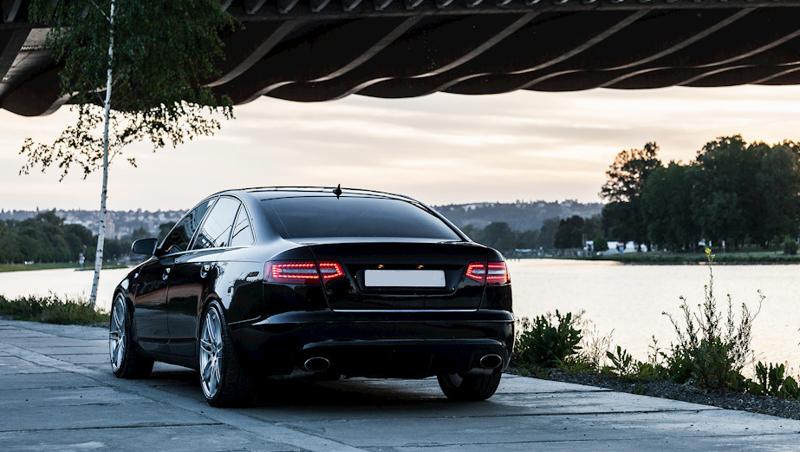
Suspension Audi A6 (C6) with mileage
In general, the suspension of the sixth generation Audi A6 is quite reliable, but you need to be prepared for the fact that every 100,000 km a considerable investment in the chassis will be required. The upper levers are the first to give up, this happens approximately on a run of 80-90 thousand km. Approximately at the same run, the steering tips also need to be replaced. Wheel bearings and live 90-110 thousand km ( change in assembly with the hub), the stabilizer struts can last the same amount. ball joints ( change assembly with lever) and shock absorbers go 100-120 thousand km. Silent blocks and rubber bushings nurse 150-200 thousand km.
The rear suspension in rare cases requires intervention up to 150,000 km. The only thing that can bother in the rear suspension is the caliper guides and pad mounting brackets ( may rattle when driving on uneven surfaces). An air suspension was also installed on the Audi A6 (C6), but such instances are not common, and thank God, since the reviews about it are not the best ( low reliability, complex repairs, expensive spare parts). The steering is reliable and, as a rule, does not cause any special problems, but sometimes the steering effort regulator fails, which leads to a decrease in the efficiency of the hydraulic booster.
Salon and electronics
Electronics is the most problematic part of the Audi A6 (C6), and when you find out about the cost of repairs, you feel uneasy ( 72 control units for various systems are installed in the car). Here, for example, the seat heating control unit, its diagnostics and flashing will cost 100-150 USD, and for the replacement of a faulty unit, you will have to pay about 500 USD. The high cost is due to difficult access to electronic components, and the replacement of any of the blocks requires prescribing in the system, even replacing the battery is not complete without adaptation. Because of this, finding a car with a mileage of 100-120 thousand km, in which the front panel has not been disassembled at least once or the door trim has not been removed, is almost unrealistic. This is the main cause of extraneous sounds while driving on uneven road surfaces ( squeaks, knocks, etc.).
The main sores of the Audi A6 (C6) electronics are:
- multimedia system ( stops reading discs). To fix the problem, you need to clean the reader ( sometimes a cleaning disc helps).
- Due to poor contact on the wire block, the quality of radio wave reception is deteriorating. The problem is eliminated by crimping the wires.
- Possible failure of the force regulator on the steering wheel. The problem is manifested by a suddenly heavier steering wheel, even at speed.
- Faulty climate control system stuck heater valves). It is required to clean the valve block ($ 100-150), if the block does not help, you will have to change it ($ 800).
- Often the parking system fails. The reason is in space sensors.
- By 100,000 km, problems with the electronic parking brake appear. The wiring is frayed, which leads to the failure of the actuators (repair will cost 500-700 USD).
- On a run of 120-140 thousand km, the headlight corrector unit fails.
If we talk about the quality of finishing materials, then they are on high level and do not cause any complaints even after for long years operation. 
Demand for the Audi A6 C6 series is high: if the car is in good condition, it sells very quickly. Most copies of Russian market imported from Europe, the rest - from the USA or officially sold in Russia. In Europe, the A6 C6 was the best-selling car in the segment for three consecutive years from 2005 to 2007, with a turnover of about 120,000 units per year.
Prices for an Audi A6 C6 in good condition start at 400-500 thousand rubles, while for more recent copies they ask for about 1,000,000 rubles. The fall in value is generating interest in the car from people who are not really able to maintain it. Having bought a used A6 with the last of his money, or, worse, on credit, the owner soon realizes that operating costs "bring him to his knees." Moreover, the complexity of the design of the A6 C6 excludes the possibility of independent or cheap repairs.
With regards to copies from Germany, it must be understood that the Germans got rid of the "good" Audi A6 for two reasons: after serious accident or because of the high mileage, reaching 300,000 km. An annual mileage of 50,000 km is common in Europe. Honest owners of autocommission shops argued that buying an A6 in Germany from the first owner for resale was unlikely. Such copies are very expensive, and do not provide an opportunity to make good money. One of the used car dealers admitted that the odometer reset procedure is in the order of things, and it is more difficult than in the previous version, but easier than in the BMW 5 E60.
Body and interior.
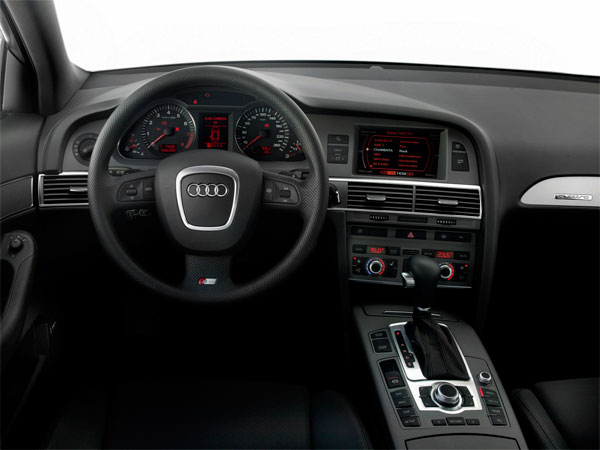
The organization of the internal space can only be described in one word - amazing! As a result of the location of the engine in front of the front axle, and not behind it, in the depths of the body, as in BMW, it was possible to get a huge cabin. The disadvantage of this arrangement is the large front overhang, which is why many drivers damage the front bumper while parking at high curbs.
A6 has the largest trunk in its class - 555 liters, while in BMW it is 35 liters less, and in Mercedes - 15 liters. The shape of the Audi trunk is more correct. Under the floor there was a place for a full-size spare wheel and battery installed on the right side.
In the case of Audi, there is no need to be afraid of rust. Vehicles from Ingolstadt are renowned for their good corrosion protection, "double galvanized" sheet metal. Body elements of the front of the A6 C6 are made of aluminum, like the BMW 5 Series E60. If during the inspection “red spots” are found, especially on the hood, fenders and trunk lid, then you can be sure that the car has had accidents in the past. It was the hood and fenders that were originally made entirely of aluminum, which is not subject to corrosion. Often, after damage, cheap alternative substitutes made of heavier sheet metal are installed. However, in Lately traces of corrosion can be found in the threshold area.
Chassis.

Aluminum parts are also used in the suspension. For example, the front lower wishbones. The suspension has a complex multi-link design, which is common for this class. However, chassis elements wear out too quickly. The front levers, as a rule, have to be sorted out every 100,000 km (from 17,000 rubles for a set of levers). The rear levers nurse up to 200,000 km.Front wheel bearings can make noise after 100-120 thousand km.
As options, the A6 offered air suspension with the ability to change the clearance (included in the basic equipment of the Allroad model). The air suspension is more reliable than the Mercedes analogue, but do not forget that when it comes to replacing shock absorbers with built-in pneumatic elements, the service will issue a five-figure bill - 70-80 thousand rubles. Failures in the system are often caused by rotten wiring (about 8,000 rubles). If you travel for a long time with a faulty pneumatic system, then the compressor and valve block may fail (over 23,000 rubles).
The Audi A6 is able to surprise with very effective brakes, but the front brake discs and pads wear out pretty quickly. And the cost of replacement will certainly disappoint you. An electric parking brake was standard equipment. Its malfunctions are common (more often due to wiring problems).
Electronics.
Audi A6 C6 received big number various electronic systems. Unfortunately, with age, owners have to deal with minor malfunctions in its operation. For example, parking sensors fail (from 1,000 rubles for an analogue or 5,000 rubles for an original). Or the cooling system fan control unit fails (contacts rot).
All vehicles are equipped with a Multi Media Interface - MMI for short. This is an integrated on-board electronics system with a display in the center console and a controller between the front seats. There are several varieties of it: 2G Basic, 2G High, and after restyling 3G with navigation, DVD and hard drive. MMI does not allow as many nodes to be controlled as BMW's iDrive. The Audi driver can only find out how soon he needs to report for maintenance. However, using the diagnostic interface, you can unlock hidden features, such as oil level detection or battery charge voltage. With the help of VAG-COM or VCDS, it is quite possible to independently change many parameters of various devices. However, without proper knowledge, it is easy to bring the car to a complete blockage.
Transmission.
The least stable is the Multitronic CVT, which is present only in cars with front axle drive. Problems with the variator may arise after 100,000 km. Much more reliable is the Tiptronic automatic with a classic torque converter, which was used exclusively in Quattro all-wheel drive modifications.
Audi claims that it is not necessary to change the oil in the box, but this is not true. Without an oil change, automatic transmissions reach a maximum of 200-250 thousand km, and Multitronic ends even earlier. It is recommended to change the oil every 60,000 km. Then the machine is able to cover more than 400,000 km. In case of problems with any of the automatic transmissions, before going to the service, you should stock up on an amount of about 100,000 rubles.
Drive unitQuattro.
The Quattro all-wheel drive system is available in all variants, with the exception of cars with 2-liter engines. Traction to the wheels is transmitted constantly to all four wheels, but in a different ratio. Torsen central differential is responsible for the distribution of torque along the axes. In addition, an electronic simulation of the differential lock mechanism is used on the front and rear axles.
It should be noted that the all-wheel drive system is very reliable. Faults are extremely rare, and even then, only among those who like to "light up": the transfer case bearings wear out, and the shank play appears.
The manufacturer claims that transmission fluid filled for the entire service life. But in reality, the fluid resource is much less than the transmission itself - a hum appears. It is recommended to change the oil at least once every 100,000 km.
Engines.
The palette of motors includes 20 various options, of which 12 are gasoline.

In the short term, the cheapest to operate are gasoline engines especially the 3 liter one. a common problem gasoline units - unstable ignition coils. Owners of diesel versions will face high costs for the replacement of expensive equipment.
The most risky is the 2.0 TDI diesel with unit injectors. The most common defects are wear on the oil pump drive and cracking of the block head. In addition, failures plagued the pump injectors and the EGR valve.
In 2007, the 2-liter turbodiesel received a Common Rail injection system, and the shortcomings were eliminated. However, he began to cause problems with the injection pump. Keep in mind that the 140-horsepower and 170-horsepower versions of the power plant have many design differences. The most important of these is the presence in a more powerful motor of piezoelectric injectors that cannot be restored.
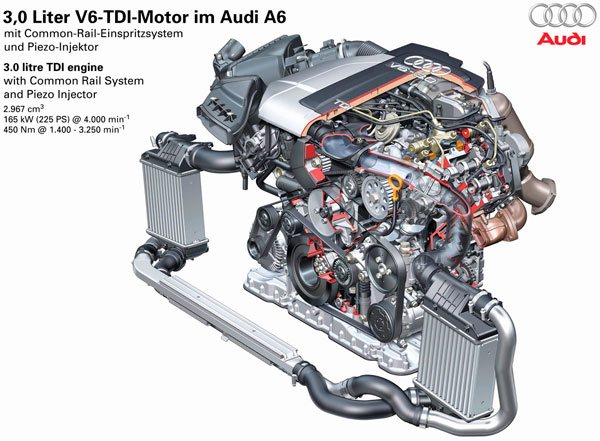
Diesel V6s cause a lot of controversy. All engines use a Common Rail type injection system and a chain-type timing drive, which includes a group of chains. Unfortunately, it cannot be called unattended. After about 150-200 thousand km, problems arise with the upper timing chain tensioner. If the chain were placed in the usual place - in front of the engine, then the replacement would not be difficult. But Audi engineers went too far, placing the timing drive on the side of the gearbox. Therefore, to get to the tensioner, it is necessary to completely dismantle the engine. IN best case for repairs will have to pay 50-60 thousand rubles.
Some owners ignore the noise of the camshaft drive chain, claiming that this is normal. In an advanced case, when the noise becomes too loud, the chain can jump a couple of teeth, which can damage the valves. In this case, the repair will require at least 100,000 rubles. After restyling in 2008, the problem with the tensioner was solved. However, by 250,000 km, the timing chain is often stretched.
Also in TDI engines there are malfunctions typical of modern diesel engines. For example, a malfunction of the intake manifold flaps that change its length. The cost of a new collector is about 30,000 rubles. In addition, the throttle assembly (gear wear) or the differential pressure sensor of the DPF filter may fail. After 200-250 thousand km, you should be ready to replace the turbocharger.
Nevertheless, there is no doubt about the durability of diesel engines. If you replace, albeit expensive, a faulty unit, then you can continue to drive almost forever. It is not uncommon for an A6 with a 2.0 TDI engine to run 500,000 km in 4-5 years as a taxi, and continue to work properly further. However, many owners, in anticipation of big expenses, simply give away their car for little money.
Gasoline engines require less maintenance costs as long as they are in good condition. However, in the case of TFSI, it is not uncommon for the ignition coils, thermostat, and sometimes the intake manifold to cause trouble. The latter ailment is very expensive to eliminate. The 2.0 TFSI has a complex equipment, and the simplest in design is a 2.4-liter V6 without a direct injection system. True, it is not without flaws.
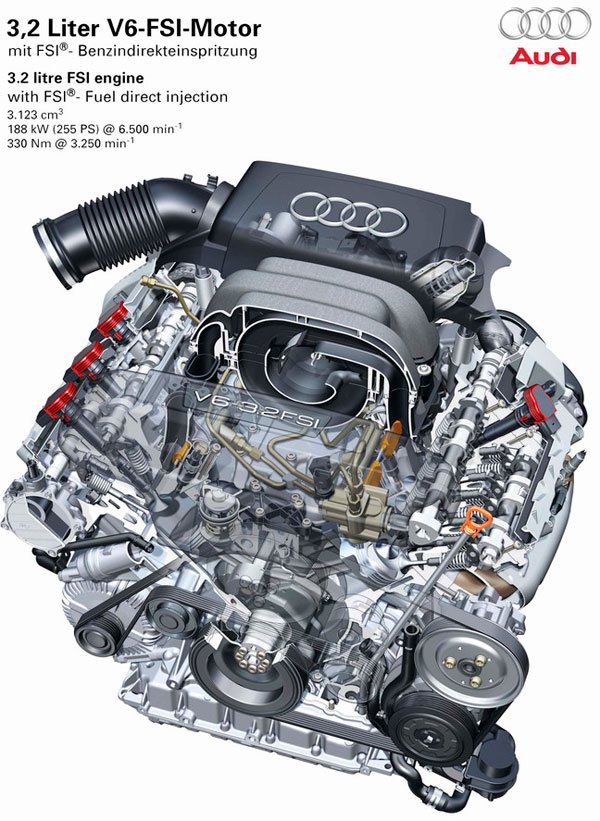
Engines 2.4, 2.8 FSI, 3.2 FSI and 4.2 FSI have problems with the timing chain drive similar, in fact, to the 3.0 TDI: premature wear and difficulty in replacing (timing drive from the box). Some experts have adapted to change the timing chain drive of 2.4, 2.8 and 3.2 liter engines without removing the engine.
All atmospheric gasoline units, with the exception of the 3-liter, sometimes present unpleasant surprises in the form of scoring and, as a result, excessive oil consumption. There are several reasons: faulty fuel injectors that flush oil from the cylinder walls; tightening with oil change; low-quality oil and lack of control over its level.
Operation and costs.
A typical problem with the restyled version is burning LED lights (LED) in the headlights and taillights. Apparently, the engineers considered that they would be eternal, since they did not provide for the possibility of replacing the LEDs separately from the headlight. Fortunately, craftsmen have learned how to restore the performance of optics by replacing burned-out LEDs and resistors. In copies produced in the early years, the MMI system sometimes freezes. In this case, installing new software often helps. But sometimes you can’t do without visiting a specialized service.
Unfortunately, we have to admit that the image of the Audi A6 C6 is a bit overrated. Some copies constantly annoy with malfunctions, especially cars of the initial period of production. Buying a good A6 for 400-500 thousand rubles is quite realistic, but it is unlikely that it will fully satisfy the owner in the future. Only cars after restyling in 2008 became more thoughtful and reliable. Worst of all, neither low mileage nor regular visits to the dealer service station protect against many malfunctions.
While the Audi A6 has not broken down, it is difficult to find serious flaws in it. Excellent finishes, rich equipment and the most spacious interior in the class are a real delight. The interior looks great with no signs of fatigue even after two three hundred thousand kilometers. This is very pleasing to any kind of merchants who, without any fear, rewind the odometer counter back 100-200 thousand km.
Positive emotions are added by powerful engines and the Quattro all-wheel drive system. However, significant defects in gasoline engines are of concern, the likelihood of which increases with increasing mileage.
Special versions.
AudiA6All road
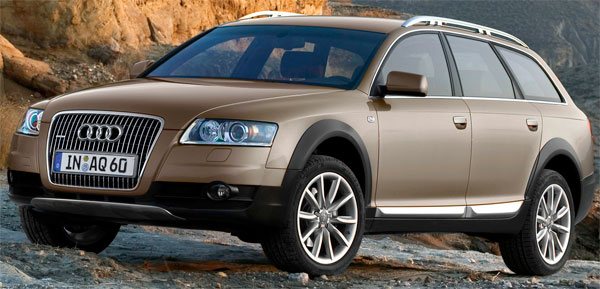
The Audi A6 Olroad was produced from 2006 to 2011. All cars on the standard equipment list had an all-wheel drive system and air suspension. As engines, petrol 3.2 or 4.2 liters and diesel - 2.7 and 3.0 TDI were offered. The vast majority of copies have a Tiptronic automatic transmission. The cost of the car is very high.
AudiS6 andRS6
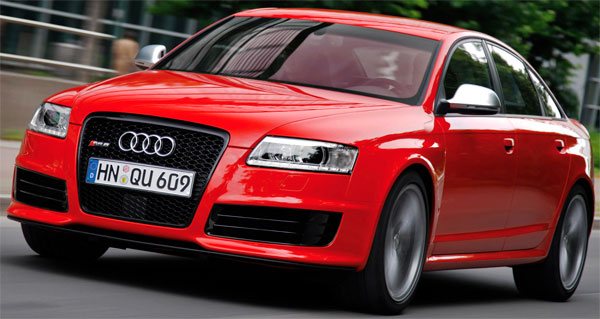
While the S6 looked pretty "decent", the RS6 introduced in 2008 was a real monster with heavily flared wheel arches. Both models used a V10 engine: the S6 had a displacement of 5.2 liters and produced 435 hp, and the RS6 5.0 liter produced 580 hp. At first, the RS6 was only available as an Avant station wagon, but a year later, a sedan appeared.
The 5.2-liter V10 has the same basic design as the 3.2 and 4.2-liter engines. V10 has a tight layout - neighboring cylinders are too close. As a result, the motor experiences huge thermal loads, which contributes to the rapid aging of the oil. The use of oils of the "Long Life" type and, accordingly, long replacement intervals contributed to the wear of the engine even in the first 100,000 km. The problem affected almost all instances of 2007-2008. Later made a number of changes, including a shorter oil change interval, but high risk overhaul preserved.
Specifications:
Audi S6 C6: 5.2 V10, power - 435 hp, torque - 540 Nm, maximum speed 250 km / h, acceleration 0-100 km h - 5.2 seconds
Audi RS6 C6: 5.0 V10 biturbo engine, power - 580 hp, torque - 650 Nm, top speed - 250 km / h, acceleration 0-100 km / h - 4.5 seconds
StoryAudiA6 C6.
2004 - end of production of A6 C5, debut of A6 C6.
2005 - start of sales, the appearance of the Avant station wagon version.
2006 - the appearance of the Allroad modification (only in the station wagon body with air suspension). The lineup replenished the S6 with a V10 engine.
2007 - 2.8 FSI appeared in the engine line.
2008 - restyling, affecting the front and rear of the body. Behind there are LED lights. In front of the modified bumper and fog lights. Inside, a new central display was installed, the instrument panel was changed, and a new MMI 3G controller was introduced. RS6 presentation.
2010 - End of RS6 production.
2011 - the new generation A6 sedan C7 is introduced.
AudiA6 C6 - typical problems and malfunctions:
- - failure of the dampers in the intake manifold 3.0 TDI
- - failure of the oil pump drive in the 2.0 TDI engine
- - defective timing chain tensioner and problems with injectors in 2.7 and 3.0 TDI engines
- - failure of the pneumatic system
- - problems with continuously variable transmission Multitronic
- - oil pressure sensor failures
- - problems with the trunk lock
- - water ingress into the additional brake light of the Avant station wagon
AudiA6 C6 in reliability ratings
GTÜ: Vehicles under 3 years old received a bad mark for brakes. For other parameters, the result is better than the average values in the class.
T Ü V : cars aged 4-5 years were rated excellent and ranked 19th in the reliability rating. Audi A4 and A8 are higher in the same rating.
DEKRA: in 87.7% of the examined A6 C6 there were no technical defects. Serious faults were found in 3.5% of cars, and minor faults in 8.8%.
- - petrol modification with a 3-liter engine and mechanical box gears - the cheapest offer among used A6
- - cars with traditional suspension and all-wheel drive Quattro
- - versions with 3.0 TDI and complete history service
Avoid:
- - 2.0 TDI with unit injectors - regardless of mileage
- - vehicles with Multitronic CVT
- - diesel versions with 3.0 TDI whose service history cannot be verified
- - cars with any malfunctions and powerful S6 with a 5.2-liter V10. Any repair will be astronomically expensive.
Advantages:
- - perfect protection against corrosion
- - the most spacious salon among German classmates
- - excellent all-wheel drive system
- - very large trunk
Flaws:
- - unsuccessful turbodiesel 2.0 TDI pre-styling version
- - very complex front and rear suspension design
- - most of the copies on the secondary market have an unsatisfactory technical condition, twisted odometers and traces of recovery after an accident
|
Version |
2.0TFSI |
2.4 |
2.8 FSI |
2.8 FSI |
2.8 FSI |
|
Engine |
petrol turbo |
petrol |
petrol |
petrol |
petrol |
|
Working volume |
1984 cm3 |
2393 cm3 |
2773 cm3 |
2773 cm3 |
2773 cm3 |
|
R4/16 |
V6/24 |
V6/24 |
V6/24 |
V6/24 |
|
|
Max Power |
170 HP |
177 HP |
190 HP |
210 HP |
220 HP |
|
Max Torque |
280 Nm |
230 Nm |
280 Nm |
280 Nm |
280 Nm |
|
Dynamics |
|||||
|
Max speed |
228 km/h |
236 km/h |
238 km/h |
237 km/h |
240 km/h |
|
Acceleration 0-100 km/h |
8.2 sec |
9.2 sec |
8.2 sec |
8.4 sec |
7.3 sec |
Specifications: Audi A6 C6 (2004-2011) - petrol versions.
|
Version |
3.0TFSI |
3.2 FSI |
4.2 |
4.2 FSI |
|
Engine |
petrol turbo |
petrol |
petrol |
petrol |
|
Working volume |
2995 cm3 |
3123 cm3 |
4163 cm3 |
4163 cm3 |
|
Arrangement of cylinders / valves |
V6/24 |
V6/24 |
V8/40 |
V8/32 |
|
Max Power |
290 HP |
255 HP |
335 HP |
350 HP |
|
Max Torque |
420 Nm |
330 Nm |
420 Nm |
440 Nm |
|
Dynamics |
||||
|
Max speed |
250 km/h |
250 km/h |
250 km/h |
250 km/h |
|
Acceleration 0-100 km/h |
5.9 sec |
6.9 sec |
6.5 s |
5.9 sec |
|
Average fuel consumption in l/100 km |
11.7 |
10.2 |
Gasoline engines - a brief description
The 2.0 TFSI is the only 4-cylinder petrol engine in the range. In other VW Group vehicles, it has higher power. In this model, he is assigned the role of the base motor. power unit too weak and has serious drawbacks: high oil consumption and accumulation of deposits in the block head. It is worth noting that this motor is different from those that were installed in the A4, A5 and Q5, where they earned a bad reputation as an oil eater.
2.4 - has the simplest design in the A6 C6 engine line and uses distributed fuel injection. Typical malfunctions: failure of the thermostat and dampers in the intake manifold. There is a high risk of scuffing on the cylinder walls.
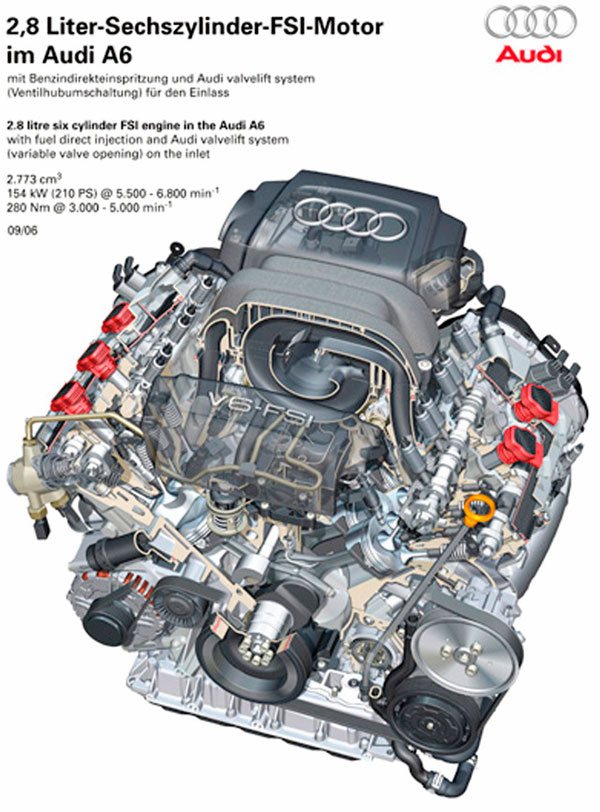
2.8 FSI - a modern engine with direct injection, variable valve timing and timing chain. He is also prone to scuffing, but it is more difficult to line the engine - the cylinder walls are too thin.
3.0 - an old design engine that was used by its predecessor. It has a belt-type timing drive, for the replacement of which it is necessary to disassemble the front of the car. The naturally aspirated V6 with port injection is very reliable, but finding a car with such an engine in good condition is a big problem.
3.2 FSI - has direct fuel injection and is usually combined with automatic transmission Tiptronic gears.
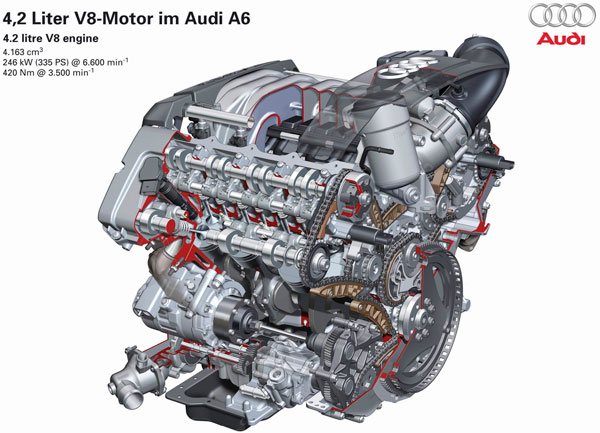
4.2/4.2 FSI - Audi's V8 sounds great and drives well. Fuel consumption at an acceptable level - 13-15 l / 100 km. Until 2006, a version with distributed fuel injection was used, and after that - with direct fuel injection (FSI). The first has a combined timing drive: belt + chain, and the second has a chain. FSI is slightly lighter and more economical, but not as durable as before. Soot accumulates on the intake valves, and there are problems with the durability of the timing chain drive. The reliability of the upper timing chain also raises questions in the version with distributed injection.
|
Version |
2.0 TDIe |
2.0 TDI |
2.0 TDI |
2.7 TDI |
|
Engine |
turbodis |
turbodis |
turbodis |
turbodis |
|
Working volume |
1968 cm3 |
1968 cm3 |
1968 cm3 |
2698 cm3 |
|
Arrangement of cylinders / valves |
R4/16 |
R4/16 |
R4/16 |
V6/24 |
|
Max Power |
136 HP |
140 HP |
170 HP |
180 HP |
|
Max Torque |
320 Nm |
320 Nm |
350 Nm |
380 Nm |
|
Dynamics |
||||
|
Max speed |
208 km/h |
208 km/h |
225 km/h |
228 km/h |
|
Acceleration 0-100 km/h |
10.3 sec |
10.3 sec |
8.9 sec |
8.9 sec |
|
Average fuel consumption in l/100 km |
Specifications: Audi A6 C6 (2004-2011) - diesel versions
|
Version |
2.7 TDI |
3.0 TDI |
3.0 TDI |
3.0 TDI |
|
Engine |
turbodis |
turbodis |
turbodis |
turbodis |
|
Working volume |
2698 cm3 |
2967 cm3 |
2967 cm3 |
2967 cm3 |
|
Arrangement of cylinders / valves |
V6/24 |
V6/24 |
V6/24 |
V6/24 |
|
Max Power |
190 HP |
225 HP |
233 HP |
240 HP |
|
Max Torque |
400 Nm |
450 Nm |
450 Nm |
500 Nm |
|
Dynamics |
||||
|
Max speed |
232 km/h |
243 km/h |
247 km/h |
250 km/h |
|
Acceleration 0-100 km/h |
7.9 sec |
7.3 sec |
6.9 sec |
6.6 sec |
|
Average fuel consumption in l/100 km |
Diesel engines - a brief description.
2.0 TDIe - A small "e" means a small sacrifice in favor of the environment: power is reduced by 4 hp, a particulate filter is installed and tires with reduced rolling resistance.
2.0 TDI 140 HP - a turbodiesel with pump nozzles, the purchase of which should be discarded. A 2-liter turbodiesel can only be considered after modernization in 2007, when a Common Rail type power system was used.
2.0 TDI 170 HP - the engine differs significantly from the 140 strong counterpart, including the presence of piezoelectric injectors that cannot be repaired.
The 2.7 TDI is the predecessor of the 3.0 TDI, has a common rail injection system and a timing chain drive. The most reliable in the pre-styling version.
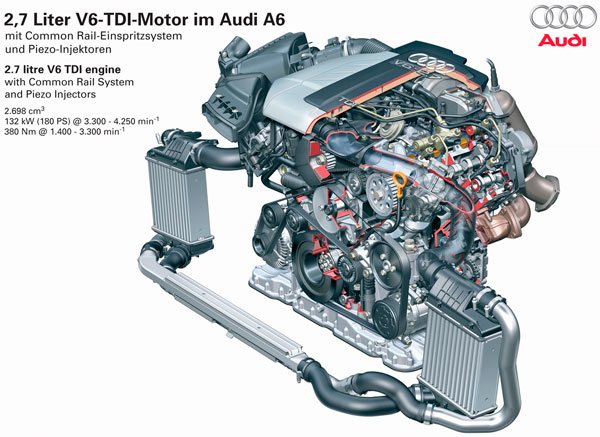
3.0 TDI - initially had many problems, in the future they were gradually eliminated by Audi engineers. A turbodiesel makes for great driving pleasure, but is very expensive to maintain and repair.
Conclusion.
Don't fool yourself. Cheap Audi A6 of the first years of production is already seriously depleted, which means they promise big expenses. It is better to pay attention to more expensive restyled copies of recent years.




